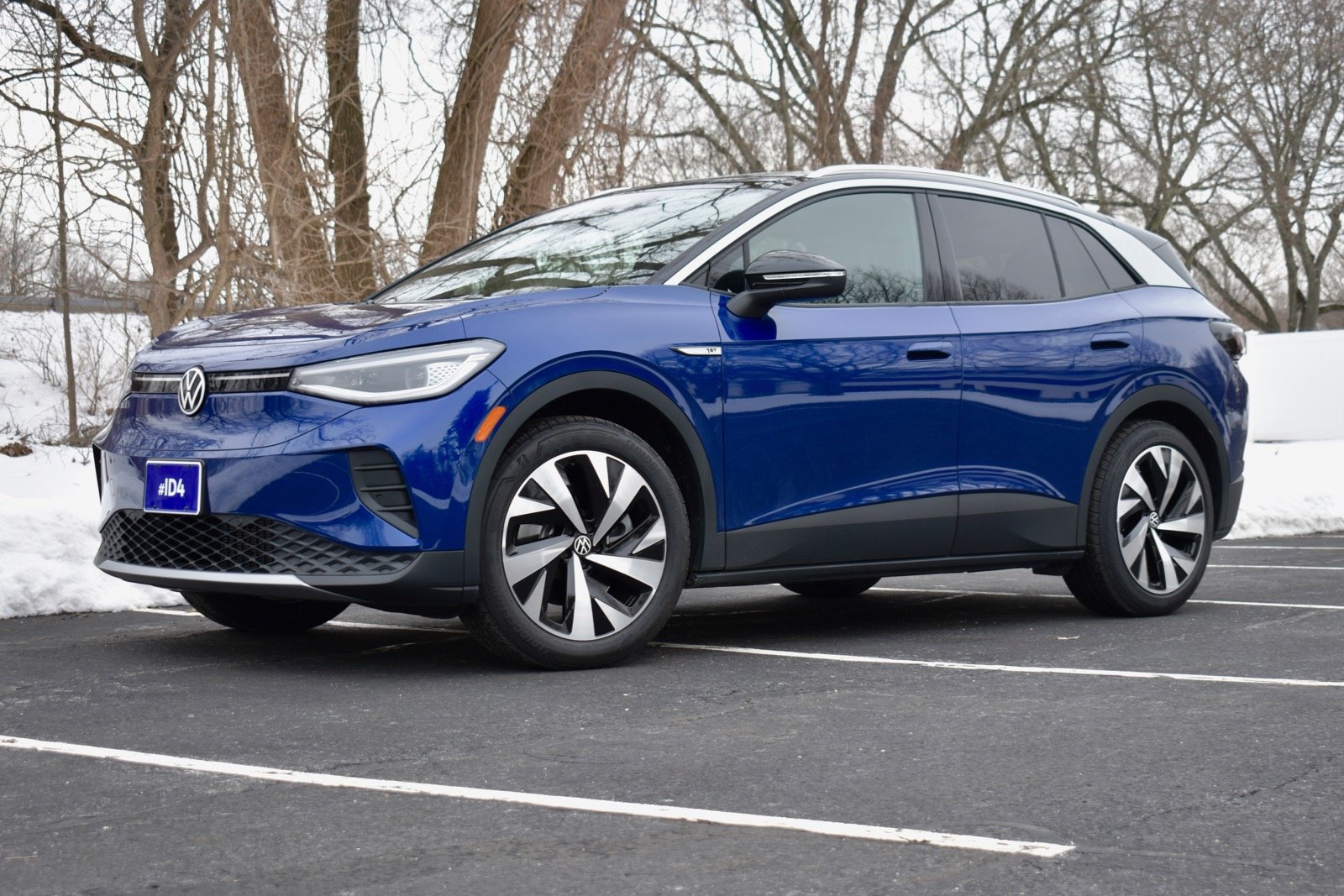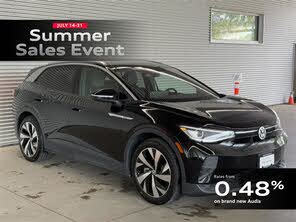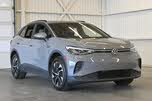2021 Volkswagen ID.4 vs 2021 Honda CR-V
Overview | |
MSRP$39,995 | MSRP$25,350 |
Listings9 | Listings464 |
Ratings & Reviews | |
User Reviews | User Reviews |
Expert reviews7.3 out of 10 | Expert reviews7.8 out of 10 |
2021 Volkswagen ID.4 Reviews SummaryThe “Dieselgate” emissions scandal forced Volkswagen to double down on electric cars, and now we’re finally seeing the first result of that: the 2021 Volkswagen ID.4 electric crossover. VW has made an electric car before, but its last attempt, the e-Golf, was built to satisfy emissions standards, not rack up sales. It was barely advertised, and it was sold only in certain locations. With the ID.4, it will launch in the three largest Canadian EV markets—British Columbia, Quebec, and Ontario—and will even be built in North America, in Chattanooga, Tennessee, starting in 2022. Volkswagen views the ID.4 as a rival not to other EVs, but to mainstream gasoline vehicles like the Honda CR-V and Toyota RAV4. Being late to the party means there are already several other EVs trying to coax new-car buyers away from internal combustion, however. If you want a reasonably priced EV, the Nissan Leaf, Hyundai Kona Electric, and Kia Niro EV already exist, and General Motors has the 2022 Chevrolet Bolt EUV—a new variant of the Chevy Bolt EV with a crossover body style similar to the Volkswagen. Our test car was an ID.4 1st Edition, a U.S.-only model released to commemorates the car’s launch. Its closest Canadian equivalent is the ID.4 RWD Pro with the Statement Package. | |
2021 Honda CR-V Reviews SummaryEven in a grim year, Honda is selling a staggering number of CR-Vs. The CR-V is the best-selling Honda in Canada, edging out the home-built Honda Civic. The CR-V is also the second best-selling compact SUV, just behind the Toyota RAV4. And it was the sixth best-selling vehicle in Canada in 2021. So, it’s hard to argue against the CR-V formula. Honda’s been at this almost as long as crossovers have been a thing, launching the CR-V in 1997—a year after the RAV4 debuted. The funny thing is, aside from sales volume, there’s only one thing the CR-V particularly excels at. Aesthetics are subjective, but it would be hard to argue the CR-V is the best-looking vehicle in its class. It’s not the cheapest. It’s not the best equipped, especially at the middle to lower trim levels. It’s not the fastest, nor is it the quietest, or the most fuel efficient. It’s not even the most reliable, showing up nowhere in J.D. Power's Most Reliable list. So, what makes it so appealing to Canadian consumers? Let’s see if we can figure that out. | |
No video found | |
Popular Features & Specs | |
Engine201 hp Electric | Engine1.5L 190 hp I4 |
Drive TrainRWD | Drive TrainFWD |
Seating Capacity5 | Seating Capacity5 |
Horsepower | Horsepower190 hp @ 5600 rpm |
EV Battery Capacity82 kWh | EV Battery Capacity |
MPG City104 | MPG City28 |
MPG Highway89 | MPG Highway34 |
Battery Charge Time (240V)8 hours | Battery Charge Time (240V) |
Engine | |
Engine Name201 hp Electric | Engine Name1.5L 190 hp I4 |
Torque | Torque179 lb-ft @ 2000 rpm |
Horsepower | Horsepower190 hp @ 5600 rpm |
Battery Charge Time (240V)8 hours | Battery Charge Time (240V) |
DrivetrainRWD | DrivetrainFWD |
Fuel Economy | |
EV Battery Capacity82 kWh | EV Battery Capacity |
MPG City104 | MPG City28 |
MPG Highway89 | MPG Highway34 |
Interior | |
Seating Capacity5 | Seating Capacity5 |
Safety | |
Front Crash Overall5 | Front Crash Overall5 |
Side Crash Overall5 | Side Crash Overall5 |
Dimensions & Capacity | |
Cargo Space30.3 cu ft | Cargo Space39.2 cu ft |
Curb Weight4517 lbs | Curb Weight3337 lbs |
Height64.4 in | Height66.1 in |
Length180.5 in | Length182.1 in |
Width72.9 in | Width73.0 in |
Wheelbase108.9 in | Wheelbase104.8 in |
Maximum Payload1347 lbs | Maximum Payload1358 lbs |
Number of doors4 | Number of doors4 |
Maximum Towing Capacity | Maximum Towing Capacity1500 lbs |
Overview | ||
MSRP | $39,995 | $25,350 |
Listings | ||
Ratings & Reviews | ||
User reviews | ||
Expert reviews | 7.3 out of 10Read full review | 7.8 out of 10Read full review |
Pros & cons | ||
Summary | The “Dieselgate” emissions scandal forced Volkswagen to double down on electric cars, and now we’re finally seeing the first result of that: the 2021 Volkswagen ID.4 electric crossover. VW has made an electric car before, but its last attempt, the e-Golf, was built to satisfy emissions standards, not rack up sales. It was barely advertised, and it was sold only in certain locations. With the ID.4, it will launch in the three largest Canadian EV markets—British Columbia, Quebec, and Ontario—and will even be built in North America, in Chattanooga, Tennessee, starting in 2022. Volkswagen views the ID.4 as a rival not to other EVs, but to mainstream gasoline vehicles like the Honda CR-V and Toyota RAV4. Being late to the party means there are already several other EVs trying to coax new-car buyers away from internal combustion, however. If you want a reasonably priced EV, the Nissan Leaf, Hyundai Kona Electric, and Kia Niro EV already exist, and General Motors has the 2022 Chevrolet Bolt EUV—a new variant of the Chevy Bolt EV with a crossover body style similar to the Volkswagen. Our test car was an ID.4 1st Edition, a U.S.-only model released to commemorates the car’s launch. Its closest Canadian equivalent is the ID.4 RWD Pro with the Statement Package. | Even in a grim year, Honda is selling a staggering number of CR-Vs. The CR-V is the best-selling Honda in Canada, edging out the home-built Honda Civic. The CR-V is also the second best-selling compact SUV, just behind the Toyota RAV4. And it was the sixth best-selling vehicle in Canada in 2021. So, it’s hard to argue against the CR-V formula. Honda’s been at this almost as long as crossovers have been a thing, launching the CR-V in 1997—a year after the RAV4 debuted. The funny thing is, aside from sales volume, there’s only one thing the CR-V particularly excels at. Aesthetics are subjective, but it would be hard to argue the CR-V is the best-looking vehicle in its class. It’s not the cheapest. It’s not the best equipped, especially at the middle to lower trim levels. It’s not the fastest, nor is it the quietest, or the most fuel efficient. It’s not even the most reliable, showing up nowhere in J.D. Power's Most Reliable list. So, what makes it so appealing to Canadian consumers? Let’s see if we can figure that out. |
Video | No video found | |
Popular Features & Specs | ||
Engine | 201 hp Electric | 1.5L 190 hp I4 |
Drive Train | RWD | FWD |
Seating Capacity | 5 | 5 |
Horsepower | 190 hp @ 5600 rpm | |
EV Battery Capacity | 82 kWh | |
MPG City | 104 | 28 |
MPG Highway | 89 | 34 |
Battery Charge Time (240V) | 8 hours | |
Engine | ||
Engine Name | 201 hp Electric | 1.5L 190 hp I4 |
Torque | 179 lb-ft @ 2000 rpm | |
Horsepower | 190 hp @ 5600 rpm | |
Battery Charge Time (240V) | 8 hours | |
Drivetrain | RWD | FWD |
Fuel Economy | ||
EV Battery Capacity | 82 kWh | |
MPG City | 104 | 28 |
MPG Highway | 89 | 34 |
Interior | ||
Seating Capacity | 5 | 5 |
Safety | ||
Front Crash Overall | 5 | 5 |
Side Crash Overall | 5 | 5 |
Dimensions & Capacity | ||
Cargo Space | 30.3 cu ft | 39.2 cu ft |
Curb Weight | 4517 lbs | 3337 lbs |
Height | 64.4 in | 66.1 in |
Length | 180.5 in | 182.1 in |
Width | 72.9 in | 73.0 in |
Wheelbase | 108.9 in | 104.8 in |
Maximum Payload | 1347 lbs | 1358 lbs |
Number of doors | 4 | 4 |
Maximum Towing Capacity | 1500 lbs | |
The 2021 Volkswagen ID.4 was crafted as a distinct electric vehicle, diverging from the traditional styling of Volkswagen's gasoline models. It showcased a streamlined profile with wheels positioned at the corners, setting it apart from the more rugged appearance of the Tiguan and Atlas crossovers. The ID.4 was part of Volkswagen's EV-specific MEB platform, following the ID.3 hatchback. While it shared some design elements with the ID.3, such as plastic body cladding and a slightly elevated ride height, the ID.4's SUV-like styling was less pronounced compared to other EV crossovers. Inside, the ID.4 combined Volkswagen's minimalist design with a tech-focused aesthetic, featuring piano black and matte plastic finishes. The base ID.4 Pro came with a leather-wrapped steering wheel and cloth seats, with leatherette upholstery available in the Statement Package.
The 2021 Honda CR-V, on the other hand, had a more conventional design that blended in with other compact crossovers. Its styling was similar to many competitors, with only minor details like the grille and chromed plastic features setting it apart. The CR-V was available in seven colours, though many were shades of grey, black, or white, with limited availability of more vibrant options like Radiant Red Metallic. Inside, the CR-V offered a modern look with angular seats and a choice of materials depending on the trim level. While it didn't stand out in terms of design, the CR-V was practical and functional, focusing on comfort and utility rather than aesthetics.
The 2021 Volkswagen ID.4 offered two powertrain configurations. The base rear-wheel drive (RWD) version featured a single rear-mounted electric motor producing 201 horsepower and 229 pound-feet of torque, powered by an 82-kilowatt-hour battery pack. An all-wheel-drive (AWD) version added a second electric motor for a total output of 295 horsepower and 339 lb-ft of torque. The ID.4's RWD setup provided balanced handling, with the front wheels steering and the rear wheels driving. While not sporty, the ID.4 prioritized comfort, offering a smooth ride over bumps and potholes. Unlike many EVs, the ID.4 relied on friction brakes rather than aggressive regenerative braking, aiming to provide a familiar experience for drivers transitioning from gasoline cars.
The 2021 Honda CR-V came with a 1.5-litre turbo four-cylinder engine producing 190 horsepower, paired with a continuously variable transmission (CVT). Its acceleration was modest, taking about 8 seconds to reach 100 kilometres per hour. The CR-V's drivetrain was less engaging compared to competitors like the Kia Sportage and Hyundai Tucson, which offered conventional automatic transmissions with sport modes. The CR-V was available with front-wheel drive (FWD) as standard, with all-wheel drive (AWD) as an option on the LX trim and standard on higher trims. Its suspension setup included a MacPherson strut in the front and a multi-link suspension at the rear, providing decent handling and ride quality.
The 2021 Volkswagen ID.4 offered more front and rear headroom compared to other EVs, though its legroom was average for the segment. It provided 858 litres of cargo space with the rear seats in place and 1,818 litres with the seats folded, surpassing several EV competitors but falling short of the Honda CR-V and Toyota RAV4. The ID.4 lacked a front trunk, opting for more cabin space instead. Its interior felt spacious, with good forward visibility but limited rearward visibility due to thick rear pillars. The ID.4 featured a unique twist-grip gear selector on the dashboard, freeing up space on the centre console, though storage options were limited.
The 2021 Honda CR-V prioritized functionality, offering more than 100 litres of interior volume compared to the Toyota RAV4. It provided 1,065 litres of cargo space with the rear seats folded, accommodating a significant amount of luggage. Depending on the trim, the CR-V offered different tailgate options, including a hands-free power tailgate on higher trims. Roof rails were standard on most trims, enhancing its practicality for carrying additional gear.
The 2021 Volkswagen ID.4 came with a standard 10-inch touchscreen infotainment system, with an optional 12-inch screen, featuring wireless Apple CarPlay and Android Auto. A 5.3-inch display screen served as the instrument cluster, and haptic touchpads replaced traditional switchgear. While the setup looked modern, it was challenging to use due to the lack of tactile feedback. The ID.4 also included a natural-language voice-control system and the ID.Light feature, which communicated information through a light strip at the base of the windshield. Despite some gimmicky features, the infotainment system was well-positioned and easy to navigate.
The 2021 Honda CR-V featured a 7-inch high-definition touchscreen infotainment system with Bluetooth, Apple CarPlay, and Android Auto connectivity. Lower trims had varying speaker setups, while the Touring trim offered a 300-watt system with a subwoofer. The CR-V included multiple charging ports throughout the cabin, with the Touring trim adding a wireless phone charger. The Touring and Black Edition trims also offered a satellite navigation system with voice recognition.
The 2021 Volkswagen ID.4 received a Top Safety Pick+ rating from the Insurance Institute for Highway Safety (IIHS) and a five-star safety rating from the National Highway Traffic Safety Administration (NHTSA) for RWD versions. It offered a range of driver aids, including forward-collision warning, automatic emergency braking, blind-spot monitoring, lane-keep assist, and adaptive cruise control. New features like Travel Assist and Emergency Assist were also included, enhancing its safety capabilities.
The 2021 Honda CR-V excelled in safety, earning a five-star NHTSA overall crash test rating and an IIHS Top Safety Pick award. It featured the Honda Sensing system, which included a suite of advanced safety features as standard across all trims. These features included a multi-angle rearview camera, forward collision warning, lane departure warning, automatic emergency braking, lane keeping assist, adaptive cruise control, and auto high-beam headlamps. The only feature not standard on the base LX trim was blind spot monitoring with rear cross-traffic alert.
CarGurus highlights

According to CarGurus experts, the overall rating for the 2021 Volkswagen ID.4 is 7.3 out of 10, while the 2021 Honda CR-V scores 7.8 out of 10. Based on these ratings, the Honda CR-V is the recommended choice, offering a better balance of practicality, safety, and overall value.
Choose the 2021 Volkswagen ID.4 if:
- You prefer an electric vehicle with a distinctive design and modern interior.
- You value a smooth and comfortable ride with balanced handling.
- You want advanced safety features like Travel Assist and Emergency Assist.
Choose the 2021 Honda CR-V if:
- You need a practical and spacious vehicle with ample cargo capacity.
- You prioritize safety with a comprehensive suite of standard features.
- You want a reliable and functional crossover with a proven track record.
CarGurus highlights

According to CarGurus experts, the overall rating for the 2021 Volkswagen ID.4 is 7.3 out of 10, while the 2021 Honda CR-V scores 7.8 out of 10. Based on these ratings, the Honda CR-V is the recommended choice, offering a better balance of practicality, safety, and overall value.
Choose the 2021 Volkswagen ID.4 if:
Shop Now- You prefer an electric vehicle with a distinctive design and modern interior.
- You value a smooth and comfortable ride with balanced handling.
- You want advanced safety features like Travel Assist and Emergency Assist.
Choose the 2021 Honda CR-V if:
Shop Now- You need a practical and spacious vehicle with ample cargo capacity.
- You prioritize safety with a comprehensive suite of standard features.
- You want a reliable and functional crossover with a proven track record.

By: CarGurus + AI
At CarGurus, our team of experienced automotive writers remain at the heart of our content operation, conducting hands-on car tests and writing insightful guides that are backed by years of industry experience. To complement this, we are harnessing AI to make our content offering more diverse and more helpful to shoppers than ever. To achieve this, our AI systems are based exclusively on CarGurus content, ratings and data, so that what we produce is both unique to CarGurus, and uniquely helpful to car shoppers.























































